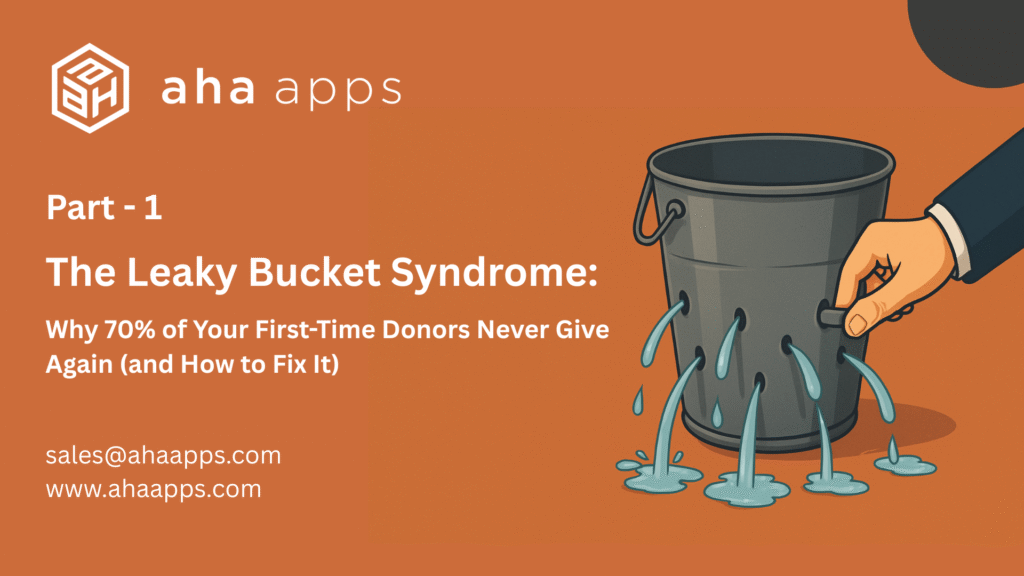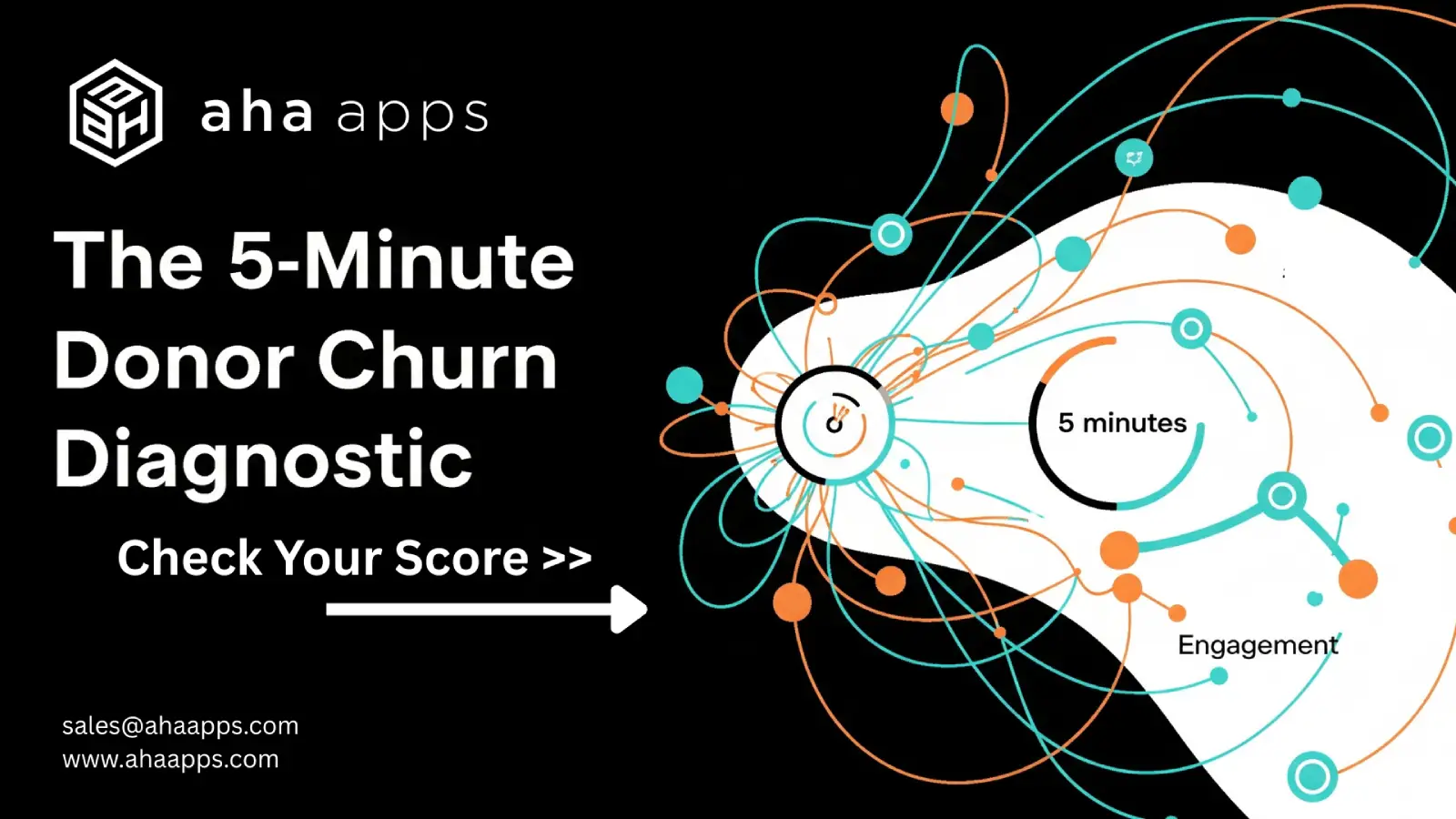Sep 29th, 2025
By Satish Reddy | Reading time 6 mins
The Leaky Bucket Syndrome: Why 70% of Your First-Time Donors Never Give Again (and How to Fix It) – Part 1
You did it. Your latest fundraising campaign was a success, bringing in a wave of new, first-time donors. It’s a moment of celebration, but for many nonprofit leaders, it’s tinged with a nagging worry. If you’re like most, you have a sinking feeling that you won’t see the majority of these new supporters again.
Unfortunately, that feeling is backed by staggering data. On average, a staggering 70% of donors make only a single contribution to a nonprofit. The Fundraising Effectiveness Project (FEP) recently found that only 19.6% of first-time donors in 2024 made a second gift.
This phenomenon has a name in our industry: The Leaky Bucket Syndrome. It’s the constant, exhausting cycle of pouring massive effort into acquiring new donors, only to watch them silently slip away through holes in your retention strategy. It’s a systemic problem that leaves teams feeling burnt out and hampers long-term growth. But what if you could plug those holes for good?

Take The 5-Minute Donor Churn Diagnostic.

The Data Behind the Donor Drop-Off
Losing donors is more than just a line item in a report; it’s a direct threat to your mission’s sustainability. While overall donor retention rates hover at a concerning 46.6% in North America, meaning organizations can lose nearly half their donor base each year, the situation for new donors is far more critical.
When nearly 70-80% of your newly acquired supporters don’t return for a second gift, the investment made to attract them yields almost no long-term value. This forces you onto a costly “acquisition treadmill,” constantly chasing new names just to stay afloat. This isn’t sustainable, and it’s a clear sign that the initial donor experience isn’t creating a lasting connection.
Why Do They Leave? Common Reasons for the First-Time Donor Exodus
After working with hundreds of nonprofits at Microsoft, I’ve seen the same patterns emerge. Donors don’t leave because they stop caring about your cause. They leave because their experience felt transactional, not relational.
Common reasons donors lapse include:
- Impersonal or Non-Existent Thank-Yous: A generic, automated receipt is not a thank you. Donors disengage when they don’t feel truly appreciated for their contribution.
- Poor Communication Cadence: They either get bombarded with more asks or hear nothing for months. Both extremes feel alienating.
- No Visible Impact: They gave you their hard-earned money, but were never shown what it accomplished. Failure to demonstrate tangible impact is a primary reason connections weaken.
- Outdated, Disconnected Systems: This is the root cause of the other issues. When your donor data lives in scattered spreadsheets or clunky, outdated software, it’s impossible to deliver a personalized, timely, and meaningful follow-up experience. Nearly a third of nonprofits struggle with managing multiple, disconnected software systems, making a unified view of the donor impossible.
The Real Cost of a Leaky Bucket
The financial drain of the Leaky Bucket Syndrome is severe. Research shows that acquiring a new donor can cost as much as $1.50 for every dollar raised, while retaining an existing one can cost as little as $0.20 per dollar raised. You are spending seven times more to replace donors than you would to keep them.
But the cost isn’t just financial. It’s the human cost of staff burnout, as teams are buried in the manual work of constantly refilling the pipeline. It’s the strategic cost of being unable to forecast revenue or plan for future growth because your support base is so unpredictable.
Your Lifeline: A Modern CRM Built for Donors
The antidote to the Leaky Bucket Syndrome is not working harder; it’s working smarter with the right strategy, powered by the right technology. This is where a modern Customer Relationship Management (CRM) system for nonprofits becomes a game-changer.
A CRM is not just a database; it’s your central command center for building relationships. It solves the core problems that cause donors to leave by enabling you to:
- Create a 360-Degree Donor View: It unifies all supporter data—giving history, volunteer activity, event attendance, email engagement—into a single, comprehensive profile so you know exactly who you’re talking to.
- Deliver Personalized Engagement: With robust segmentation, you can tailor your messaging based on a donor’s specific interests and history, making them feel seen and valued.
- Automate with a Human Touch: Automation handles the routine tasks, like sending an immediate, personalized thank-you note, freeing your team to focus on high-touch relationship building.
- Map the Entire Donor Journey: A modern CRM allows you to track every interaction over time, guiding each supporter on a journey from first-time donor to lifelong advocate.
Why Dynamics CRM for Nonprofits Makes a Difference
Having spent years at Microsoft, I know the immense power, security, and scalability of the Dynamics 365 platform. It’s an enterprise-grade solution trusted by global organizations. Aha Impact harnesses this power and customizes it specifically for the needs and workflows of US-based nonprofits.
With Aha Impact, you get the robust capabilities of a world-class CRM, tailored to solve your most pressing fundraising challenges. Our platform provides the essential tools, like at-a-glance dashboards showing top donors, detailed reports identifying who gave last year but not this year, and comprehensive donor profiles that capture every single touchpoint.
Your First Step to Sealing the Bucket
The Leaky Bucket Syndrome is a frustrating reality, but it’s not a permanent one. It’s a systems problem, and it has a systems-based solution. By shifting from disjointed, outdated tools to an integrated, donor-centric CRM strategy, you can transform your fundraising and build the sustainable support your mission deserves.
In our next article, we’ll walk you through a step-by-step plan to seal the bucket and turn your first-time donors into lifelong supporters.
Ready to stop diagnosing the problem and start seeing the cure?
Don’t let another donor slip away. You can see exactly how a modern CRM empowers your team to build lasting relationships.
Seal the Bucket: A 5-Step Plan to Turn First-Time Donors into Loyal Supporters
Learn how to stop the donor drain and build lasting relationships. In Part 2, we reveal a practical, step-by-step strategy using Aha Impact CRM to transform one-time donors into lifelong advocates. It’s time to seal the bucket for good.